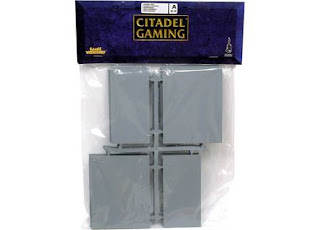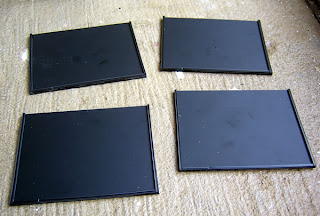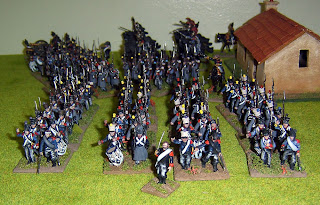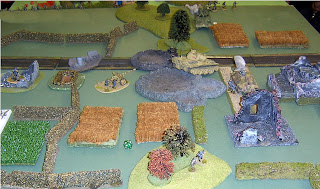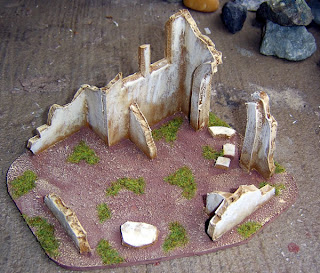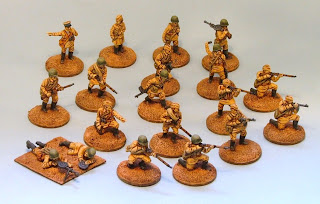I'm happy to report that I enjoyed the show much more than in the last few years, not least due to it's new and much improved home in the Royal Armouries Conference hall, as opposed to the previous exhibition hall within the main museum building.
This space is easily twice the size of the old hall and has far better lighting on top of a less claustrophobic air. It's as easy to find and still allows access to the Royal Armouries. Parking remains impossible of course!
All this seemed to attract a handful of extra traders, though it was impossible to tell if it also increased the number of visitors, still I heard positive noises from the traders to the general affect that business was up!
I encountered lots of friends over the course of my wanderings, so hello to all, this made for a pleasant diversion from meandering around the show.
And so on to the display games. At the entrance was a large display from Legendary Wargames, including their take on Albuera:

25/28mm in the Gilder style and using in the Grand Manner Rules.
 Several other static displays were set up to entice the gamer looking to fulfill his fantasies of epic games:
Several other static displays were set up to entice the gamer looking to fulfill his fantasies of epic games:
Moving on we had a large 15mm WW2 game set in the Western Desert, but for reasons best known to themselves using the Piquet rules, each to his own I suppose... I think the models were mostly Peter Pig, to my mind some of the best in the scale.
I think the models were mostly Peter Pig, to my mind some of the best in the scale. Another WW2 game, this time in 28mm. Recreating an engagement from the Italian Invasion of Greece.
Another WW2 game, this time in 28mm. Recreating an engagement from the Italian Invasion of Greece.
Well finished scenery, including some excellent trenches. Though I found the gradient of the slopes distinctly, wargamery. Pretty looking Greek figures, to face the Italians in the trenches atop the hill.
Pretty looking Greek figures, to face the Italians in the trenches atop the hill.
My main gripe with this game was that the supporting and explanatory information was so extensive it actually did a good job of hiding the game! A shame.
Moving on, for technical excellence it would be hard to beat this Zombie game, made of interlocking rooms and wired for light effects: I can't speak for the provenance of the models, though I found something distinctly pre-painted about them. I liked the idea of the clear bases however, Ideal for this sort of game. Here the security forces ready for action:
I can't speak for the provenance of the models, though I found something distinctly pre-painted about them. I liked the idea of the clear bases however, Ideal for this sort of game. Here the security forces ready for action:
Whilst below, a zombie seems attracted to a pulsating power source. From modern technical gaming, to the traditional. The Lance and Longbow Society roll out their Renaissance forces (Fornovo 1495, I'm informed) once again. Colourful, but not in any way sensational; but a perfectly acceptable club game.
From modern technical gaming, to the traditional. The Lance and Longbow Society roll out their Renaissance forces (Fornovo 1495, I'm informed) once again. Colourful, but not in any way sensational; but a perfectly acceptable club game. Finally my favourite of the show, out of my biased selection (I've not included several games, including the less photogenic and those I'd seen before). A modest but very effective 15mm Napoleonics game, played using Lasalle. I'm not sure if it was any particular engagement, though of course it looked reminiscent of part of Waterloo to me.
Finally my favourite of the show, out of my biased selection (I've not included several games, including the less photogenic and those I'd seen before). A modest but very effective 15mm Napoleonics game, played using Lasalle. I'm not sure if it was any particular engagement, though of course it looked reminiscent of part of Waterloo to me. The scenery just looked right, without being spectacular, the figures numerous and pleasing without being of an unattainable standard. All in all what any gamer can and should aspire to!
The scenery just looked right, without being spectacular, the figures numerous and pleasing without being of an unattainable standard. All in all what any gamer can and should aspire to!
So what have we learned; a few things; an effective game for a show need not be the most visually impressive, but should have some form of wow factor. It should have supporting information but not be dwarfed by its material. The rules, if the game is to be played should be well known by the umpires, and simple enough to allow the casual player to need to remember nothing, and be in and out in half an hour or so. It's acceptable for a game to just sit there, but if so it must be markedly prettier.
And why does any of this matter? Well, my next project is a display game for Pudsey Recon in a scant six weeks time. So myself and my co-conspirator Neil needed to brush up on what we wanted to do for our own efforts.
More to follow...
